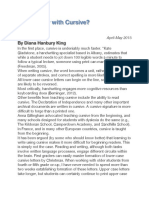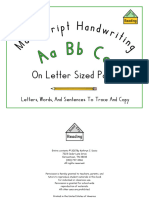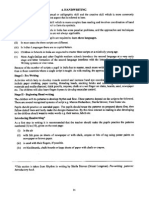Steps to Teaching Your Child Cursive Handwriting
Step 1: Introduce one cursive letter at a time
Think of your child as re-learning to write the alphabet one letter at a time. Each letter should be
introduced slowly and practiced consistently before moving on to the next step.
Step 2: Begin with teaching lowercase cursive letters
Begin by teaching only the lowercase letters of the alphabet. Start with letters that are similar in form to
print letters such as c, a, d, and g. You may also group letters together by formation patterns and
difficulty. Begin with the simplest letters and end with the most difficult and infrequently used ones.
1. c, a, d, g
2. h, t, p, e, l, f, q
3. u, i, j, k, r, s
4. o, b, v, w
5. m, n, y, x, z
Step 3: Then teach uppercase cursive letters
Once the lowercase letters are mastered, begin pairing them with the uppercase version in this order.
1. A, C, O, U
2. V, W, X, Y, Z
3. P, R, B, H, K
4. N, M, J, F, T
5. I, D, L, G, S
6. E, Q
�Step 4: Have your child copy simple sentences
After introducing and practicing upper- and lowercase letters, have your child start copying simple
sentences. Be sure to observe and demonstrate how to connect letters together.
Here are a few examples from Daily Handwriting Practice: Contemporary Cursive:
A continent is a large landmass.
North America is north of the equator.
South America is south of the equator.
Download this free sample page from Daily Handwriting Practice: Contemporary Cursive.
Step 5: Progress to copying simple paragraphs
Copying simple and short paragraphs is the last step in learning how to write in cursive. Continual
practice using many different letters is the key to mastering cursive handwriting.























































